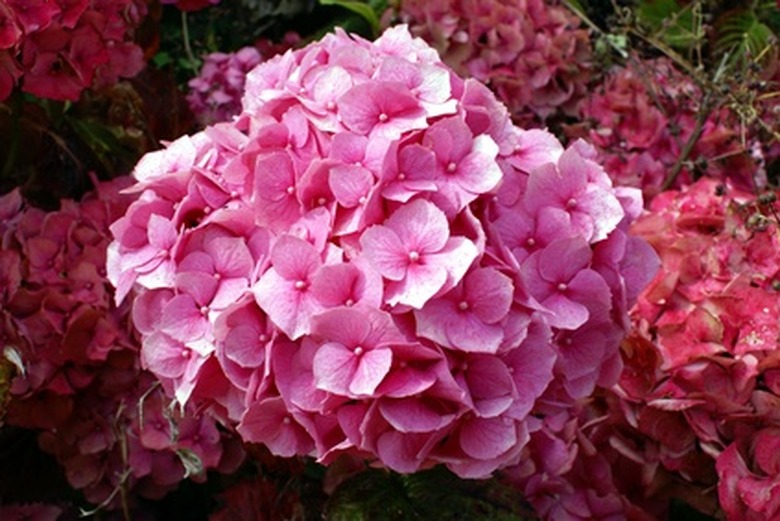pH For Hydrangea Colors
Hydrangeas bloom from late spring or early summer well into fall. These handsome ornamental shrubs sport small individual flowers that form showy clusters. When in bloom, these clusters envelop the shrub, making an impressive sight. Some hydrangeas, such as the oakleaf hydrangea (Hydrangea quercifolia), yield panicles of white flowers. Other types, including the bigleaf hydrangea (Hydrangea macrophylla), can have flowers of pink or blue, depending on the type of soil in which they are rooted. Many gardeners change their soil pH to control the color of the blooms.
Color
Soil pH determines the color of pink and blue hydrangeas. Slightly acid to slightly alkaline soils with a pH of 6 to 7.5 will result in pink flowers. Acid soil with a pH of 5.5 to 5 yields blue or purple hydrangeas. If the soil pH is between 5.5 and 6, the blooms tend to turn less desirable shades of mauve. White hydrangeas are not affected by soil pH at all.
- Hydrangeas bloom from late spring or early summer well into fall.
- Other types, including the bigleaf hydrangea (Hydrangea macrophylla), can have flowers of pink or blue, depending on the type of soil in which they are rooted.
Changing pH
Changing the soil's pH is not a complicated task. To raise soil pH and make it less acid, add lime. Wood ashes also raise soil pH. To lower pH and make soil more acid, add sulfur. Working peat moss into the soil at planting time also lowers pH. The quantity of lime or sulfur needed varies according to the soil's existing pH. Clay soil, for example, requires more lime or sulfur to amend than sandy soil. Have the soil tested by your county extension service to determine its pH.
- Changing the soil's pH is not a complicated task.
- To raise soil pH and make it less acid, add lime.
Care
Hydrangeas bloom on old wood, so care should be taken when pruning them. Remove only dead wood or growth that is more than 3 years old. Thin out about a third of the oldest branches each year. Plant hydrangeas in full sun to partial shade on a site large enough to accommodate the shrub's mature size. Choose a site protected from winter winds in the North and from afternoon sun in the South. Hydrangeas are hardy in U.S. Department of Agriculture zones 3 through 9.
Uses
Hydrangeas fit naturally into woodland gardens and work well as shrub borders. Big-leaf or garden hydrangeas are deciduous shrubs that grow 4 to 8 feet tall. Climbing hydrangea (Hydrangea petiolaris) can reach up to 50 feet or more with support of a sturdy structure, such as a large tree, tall pillar or a trellis firmly anchored into the soil and propped against a wall. Oakleaf hydrangea can grow up to 6 feet tall and wide.
- Hydrangeas bloom on old wood, so care should be taken when pruning them.
- Climbing hydrangea (Hydrangea petiolaris) can reach up to 50 feet or more with support of a sturdy structure, such as a large tree, tall pillar or a trellis firmly anchored into the soil and propped against a wall.
References
- ”Taylor's Guide to Growing North America's Favorite Plants”; Barbara W. Ellis; 1998
- ”All About Perennials”; Meredith Books; 2007
- ”The Book of Outdoor Gardening”; Smith & Hawken; 1996
